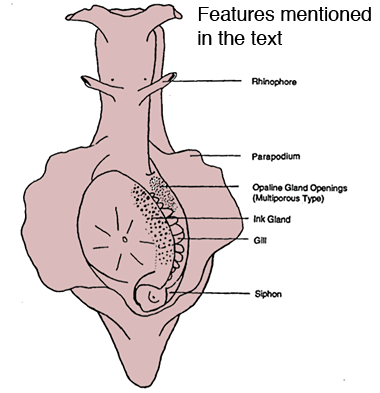Facts
Navigation Back to Interactions - Home - Continue to References
An asset to the sea hare that isn’t
known just by looking at is it the fact that it has a thick
internal shell that doesn’t contain very much calcium. This
helps fend off predators and makes up for the soft, jelly like
outer skin it has (Bezzera, Silva, Carvalho, Melo 2006). The sea
hare projects ink from an ink gland along the shell and mixes
with opaline, given off from the opaline gland (Derby, Aggio
2011). Most scientist think of the ink as a defense mechanism,
considering that is what most of the tests that are done try to
prove. It can provide a screen from predators, clouding up the
water around it, making it so the sea hare isn’t visible. The
ink is also distasteful, diluting the water around it (Bezzera,
Silva, Carvalho, Melo 2006). This ink protects against both
vertebrate and invertebrate predators. The ink contains a
protein compounds that can’t be broken down by certain
predators. The ink has been known to stick to predators,
blocking some of its sensory organs and causing it to misjudge
its chemical environment. It also contains high amounts of free
amino acids, which happen to be stimulants for a majority of
marine animal’s diets, making them drop the sea hare and go for
the ink. The ink can have a physical effect on the predators, or
it can be used as a warning sign for other sea hares to let them
know that a predator is nearby, also a way it is used as a
defense mechanism (Derby, Aggio 2011).

Source: https://www.gbri.org.au/Classes/2012/Dolabellaauricularia%7CJacintaKong.aspx?PageContentID=2788
Although having the ink as a defense mechanism is what seems to be the most efficient use for it, there are multiple other ways the ink is beneficial to the sea hare. Some believe it to be a way to get rid of all of the unnecessary bile pigments gotten from its food supply. This prevents the potential diseases and sicknesses that could be contracted from their diets. The ink can also be used as a metabolic inhibitory on the organisms in its environment (Bezzera, Silva, Carvalho, Melo 2006). After secreting all of its ink, it takes 2-3 days for the ink to fully restore. This leaves the sea hare to be vulnerable for that period of time, which is another reason for the hard inner shell. This is also a reason as to why the sea hares usually don’t travel alone (Derby, Aggio 2011). When studying the ink and opaline glands in the sea hare, there are different ways to get samples of each substance. With the ink glands, a scientist is easily able to just squeeze the ink out of the gland to get a sample to test. However, the opaline gland must be centrifuged in order to separate the opaline from the gland tissue, making it a bit more difficult to get a testable sample (Nusnbaum, Derby 2010). The ink gland has three separate vesicles in the matrix of collagen, cells, and muscles. What they choose in their diet helps determine what color of the most used vesicle is (Bezzera, Silva, Carvalho, Melo 2006).

Source:http://www.asnailsodyssey.com/LEARNABOUT/NUDIBRANCH/nudiInk.php
Back to Interactions - Home - Top of Page - Continue to References
